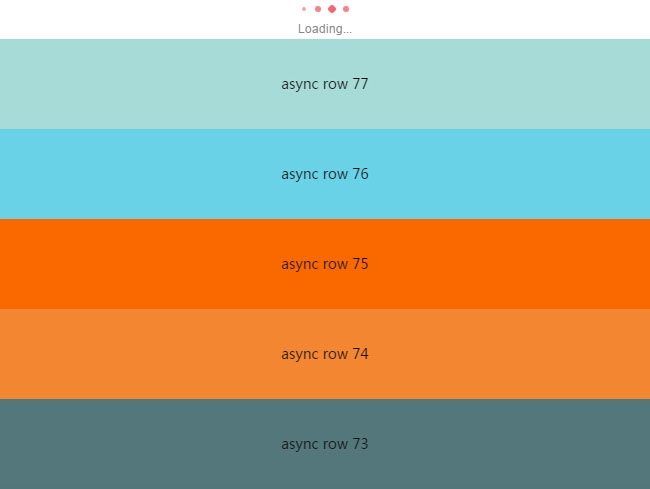
In many Apps, news or display categories have pull-down refresh and pull-up loading effects. Third-party classes that achieve this effect are provided online (see MJRefresh and EGOTableViewPullRefresh for details). It is very convenient to use, but in your spare time Yu, we can think about the principle of achieving this effect. I have said before that any animation is a lie. As long as it is not a hardware problem, most effects can be made based on the system UI.
The following code is used to refresh the page through pull-down on the jQuery mobile phone, which is very similar to the special effects code for QQ Space client or WeChat pull-down to refresh the page.
Please see the renderings below:

Online preview Source code download
html code:
<div id="wrapper">
<ul>
<li>row </li>
<li>row </li>
<li>row </li>
<li>row </li>
<li>row </li>
<li>row </li>
<li>row </li>
<li>row </li>
<li>row </li>
<li>row </li>
</ul>
</div>
<script>
for (var i = ; i < document.querySelectorAll("#wrapper ul li").length; i++) {
document.querySelectorAll("#wrapper ul li")[i].colorfulBg();
}
refresher.init({
id: "wrapper",//<------------------------------------------------------------------------------------┐
pullDownAction: Refresh,
pullUpAction: Load
});
var generatedCount = ;
function Refresh() {
setTimeout(function () { // <-- Simulate network congestion, remove setTimeout from production!
var el, li, i;
el = document.querySelector("#wrapper ul");
el.innerHTML = '';
for (i = ; i < ; i++) {
li = document.createElement('li');
li.appendChild(document.createTextNode('async row ' + (++generatedCount)));
el.insertBefore(li, el.childNodes[]);
}
wrapper.refresh();/****remember to refresh after action completed! ---yourId.refresh(); ----| ****/
for (var i = ; i < document.querySelectorAll("#wrapper ul li").length; i++) {
document.querySelectorAll("#wrapper ul li")[i].colorfulBg();
}
}, );
}
function Load() {
setTimeout(function () {// <-- Simulate network congestion, remove setTimeout from production!
var el, li, i;
el = document.querySelector("#wrapper ul");
for (i = ; i < ; i++) {
li = document.createElement('li');
li.appendChild(document.createTextNode('async row ' + (++generatedCount)));
el.appendChild(li, el.childNodes[]);
}
wrapper.refresh();/****remember to refresh after action completed!!! ---id.refresh(); --- ****/
for (var i = ; i < document.querySelectorAll("#wrapper ul li").length; i++) {
document.querySelectorAll("#wrapper ul li")[i].colorfulBg();
}
}, );
}
</script>
More details on the principles of pull-down refresh and pull-up loading, and the specific introduction is through code analysis.
The code is as follows:
// 下拉刷新的原理
- (void)scrollViewWillBeginDecelerating:(UIScrollView *)scrollView
{
if (scrollView.contentOffset.y < - 100) {
[UIView animateWithDuration:1.0 animations:^{
// frame发生偏移,距离顶部150的距离(可自行设定)
self.tableView.contentInset = UIEdgeInsetsMake(150.0f, 0.0f, 0.0f, 0.0f);
} completion:^(BOOL finished) {
/**
* 发起网络请求,请求刷新数据
*/
}];
}
}
// 上拉加载的原理
- (void)scrollViewDidEndDragging:(UIScrollView *)scrollView willDecelerate:(BOOL)decelerate
{
NSLog(@"%f",scrollView.contentOffset.y);
NSLog(@"%f",scrollView.frame.size.height);
NSLog(@"%f",scrollView.contentSize.height);
/**
* 关键-->
* scrollView一开始并不存在偏移量,但是会设定contentSize的大小,所以contentSize.height永远都会比contentOffset.y高一个手机屏幕的
* 高度;上拉加载的效果就是每次滑动到底部时,再往上拉的时候请求更多,那个时候产生的偏移量,就能让contentOffset.y + 手机屏幕尺寸高大于这
* 个滚动视图的contentSize.height
*/
if (scrollView.contentOffset.y + scrollView.frame.size.height >= scrollView.contentSize.height) {
NSLog(@"%d %s",__LINE__,__FUNCTION__);
[UIView commitAnimations];
[UIView animateWithDuration:1.0 animations:^{
// frame发生的偏移量,距离底部往上提高60(可自行设定)
self.tableView.contentInset = UIEdgeInsetsMake(0, 0, 60, 0);
} completion:^(BOOL finished) {
/**
* 发起网络请求,请求加载更多数据
* 然后在数据请求回来的时候,将contentInset改为(0,0,0,0)
*/
}];
}
}
The above content is the detailed explanation and principle of this article for jQuery to simulate the pull-up to refresh the original ecological App and the pull-down to load more pages. I hope it will be helpful to everyone.
 What are the data analysis methods?
What are the data analysis methods?
 Why can't my mobile phone make calls but not surf the Internet?
Why can't my mobile phone make calls but not surf the Internet?
 What are the css3 gradient properties?
What are the css3 gradient properties?
 What is the article tag used to define?
What is the article tag used to define?
 Win10 does not support the disk layout solution of Uefi firmware
Win10 does not support the disk layout solution of Uefi firmware
 How to create a web page in python
How to create a web page in python
 python configure environment variables
python configure environment variables
 What are the design patterns used by laravel?
What are the design patterns used by laravel?
 How to use union in c language
How to use union in c language




